Classification: Kingdom Animalia, Sub-Kingdom Metazoa, Phylum Arthropoda, Common Names: shrimps, lobsters, crabs, woodlice, insects, scorpions, spiders, centipedes, etc
Features
-
Type of organism
The Arthropoda (‘jointed legs’) is the largest animal phylum. Estimates of numbers of species vary from 0.5 to 10 million. Sizes vary from about 0.1 mm to 60 cm long. Arthropods show a protostome developmental pattern. Cilia are not found in Arthropoda.
-
Body plan
Arthropods are bilaterally symmetrical, triploblastic, coelomate invertebrates. Their bodies are usually segmented; groups of segments may specialize to form regions such as a head, thorax or abdomen. Each segment primitively possesses a single pair of jointed appendages (arguably ≡ polychaete parapodia) used for sensory purposes, feeding, locomotion or reproduction, and may also have a respiratory component. In adult arthropods, the embryonic coelom tends to become very reduced, being mainly represented as the cavities in the reproductive organs and in the pericardium. The main body cavity is a hemocoel.

-
Feeding
Many arthropods are predaceous carnivores, but herbivores, fluid-feeders and parasites are also found. There is a complete gut with a mouth and an anus: the foregut and the hindgut are lined with chitin.
-
Locomotion
The jointed limbs are used for locomotion in water and on land; movement is effected by muscle fibers attached to the inside of the exoskeleton. Insects have wings for powered and/or gliding flight.
-
Skeleton
Arthropods are enclosed in an exoskeleton (organized as an endocuticle, exocuticle and epicuticle) largely comprising a nitrogen-rich polysaccharide, chitin, which may be impregnated with calcium salts. The chitin may be rendered more waterproof by waxes (as in insects). Growth is effected by successive molts of the exoskeleton.
-
Respiration and vascular system
Discrete respiratory organs are found in arthropods: gills tend to be used by aquatic species while the more advanced terrestrial species use tracheal systems. The hemocoel provides the blood cavity for the low-pressure, open circulatory system. There is a dorsal tubular heart which works on a suction pump principle, and contractions tend to be neurogenic (i.e. nerves stimulate the heart to contract, rather than there being an intrinsic ‘myogenic’ rhythmicity to the beating of the organ).
-
Osmoregulation and excretion
Discrete excretory organs are normally found, including green (antennal) glands in Crustacea and Malpighian tubules in Insecta.
-
Co-ordination
The nervous system resembles that of an annelid, including the possession of a ventral nerve cord.
-
Reproduction
Arthropod life histories are characterized by many stages, involving molts (ecdysis) of the exoskeleton. There may be profound metamorphosis changes. Sexes are usually separate. Eggs are centrolecithal, with a yolk lying between the central nucleus and the periphery of the egg; cleavage is spiral but commonly superficial.
Sub-phyla
There are four major sub-phyla (or superclasses):
- Trilobitomorpha
- Crustacea
- Uniramia
- Chelicerata
although zoologists do not always agree about the details of arthropod classification.
-
Sub-phylum Trilobitomorpha (trilobites)
Trilobites were a dominant invertebrate form in oceans from the Cambrian to the Carboniferous period. They were oval, flattened arthropods divided into three longitudinal ‘lobes’. All the body segments articulated, allowing the trilobites to roll into a ball. The limbs were biramous (two-lobed), the inner lobe as a walking leg and the outer lobe for swimming, burrowing or perhaps used as a gill.
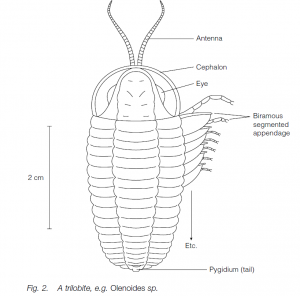
-
Sub-phylum Crustacea (shrimps, barnacles, copepods, lobsters, crabs, woodlice)
Crustaceans are mainly marine, although freshwater and a few terrestrial species exist. The exoskeleton is reinforced by calcium salts. Appendages are typically biramous (two-lobed): there are usually one or two pairs of sensory antennae, followed by biting mandibles. On the segments behind the mandibles lie one or two more feeding appendages, then the locomotory limbs. In the biramous legs, both parts may be used for swimming or the inner part may be used for walking.
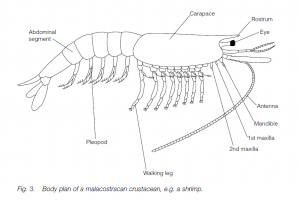
The body is usually divided into a cephalothorax and an abdomen. Respiration is usually by gills, which may be enclosed in a gill chamber. Excretion may be by a green gland (antennal gland). Many crustaceans are parasites. Six major classes are noted here:
(1) Class Branchiopoda. These free-living forms often possess a bivalved carapace which also encloses a dorsal brood pouch for eggs. The large, biramous antennae are used for swimming. Parthenogenetic (‘virgin-birth’) reproduction is common, with the production of males at only certain times of the year. An example is Daphnia pulex (water-’flea’).
(2) Class Ostracoda. These are rapidly swimming aquatic crustaceans which possess a carapace which encloses the body and the head. An example is Cythereis sp. (seed-shrimp).
(3) Class Copepoda. The copepods include free-swimming aquatic forms and also parasites which live on fish gills, often appearing as small worms. They are very common in plankton. An example is Cyclops sp.
(4) Class Branchiura. The fish-louse is an ectoparasite on fishes: it swims using its thoracic appendages. An example is Argulus sp.
(5) Class Cirripedia. The barnacles have adults which are sessile or parasitic. The shell (or carapace) comprises calcareous plates. Six pairs of thoracic appendages form a ‘net’ to trap food. Parasitic barnacles may be very degenerate. An example is Balanus sp. (barnacle).

(6) Class Malacostraca. This class comprises most of the larger crustaceans found in the sea, in freshwater and on land. The body has 20 segments (six in the head, eight in the thorax and six in the abdomen), There are several super-orders, two of which are noted here.
(i) Super-order Pericarida: This has members with a reduced carapace and a brood pouch (resulting in a frequent absence of larval stages). Included among the Pericarida are the Isopoda whose terrestrial forms include the woodlice (e.g. Oniscus sp.). Although described as terrestrial, these crustaceans need to moisten their gill-books with water. The Amphipoda include the laterally compressed freshwater shrimps with uniramous thoracic appendages.
(ii) Super-order Eucarida: The Eucarida have a carapace which covers the thorax; the eyes have stalks. There is usually a swimming, larval stage. Euphausids are important in the food chain as krill. The Decapoda include shrimps, lobsters and crabs: there are some freshwater and a few land forms, although they return to the sea to breed. The elongated lobster body format contrasts with that of the crab where the reduced abdomen is tucked under the widened thorax. Examples are Homarus spp. (lobster) and Cancer spp. (crab).
-
Sub-phylum Uniramia (millipedes, centipedes, insects)
This enormous sub-pylum contains well over one million species Almost all uniramians are terrestrial (although there are many insects which secondarily re-invaded fresh water). The exoskeleton contains tanned protein. The appendages are uniramous (i.e. have one lobe), the most anterior being the antennae. The mandible bites with the tip. The walking legs lie behind the head.
In insects, there is a sharp division between the thorax and the abdomen, but in millipedes and centipedes there are many similar segments. Insects have developed powered flight.
(1) Class Diplopoda. The millipedes have between about 25 and 100 segments, each with two pairs of legs. The head has a pair of antennae and two pairs of mouthparts. Respiration is by tracheae. They are herbivorous burrowers or live in leaf mold. An example is Spirobolus sp.
(2) Class Chilopoda. Centipedes usually have fewer segments than the millipedes. The head bears one pair of antennae and three pairs of mouthparts; the next pair of segments has poison claws. Each of the following segments has a pair of walking legs. Respiration is by tracheae. Centipedes are active, fast-moving carnivores living in leaf litter, etc. An example is Lithobius sp.
(3) Class Insecta.
(a) The subclass Apterygota.
This (sometimes erected as a class in its own right) includes the wingless springtails and silverfishes. Like all insects, apterygotes have six legs, although there is some debate about whether they originated from a uniramian ancestor separately from the winged insects. An example is Petrobius maritimus.
(b) The subclass Pterygota.
This contains the ‘true’ or winged insects. The body is divided into a head, thorax and abdomen. The thorax has three segments, each of which bears a pair of legs. Modern insects normally have four wings, outgrowths of the body wall; there is a pair of wings on each of the middle and hind segments of the thorax (the mesothorax and metathorax), although the mesothoracic wings may be modified to form ‘covers’ (elytra) in beetles, and the metathoracic wings may be reduced to ‘balancers’ (halteres) in flies, or the wings may be secondarily lost (as in some ant generations). (Palaeozoic fossil insects are known with a third pair of wings anteriorly on the prothorax.)
The head has a pair of antennae and three pairs of mouthparts, often greatly adapted to feeding habit and diet. The abdomen lacks legs, but reproductive appendages may be present terminally. Hemimetabolous insects have a series of juvenile stages (as in a locust) in which each instar resembles the adult except for the absence of wings. Holometabolous insects have a larval stage in their life histories which may be very different from the adult (e.g. a maggot or a caterpillar): metamorphosis may be profound, accomplished within a pupa or chrysalis. Insects breathe through an extensively branching system of tracheal air-ducts lined with chitin (except at the far ends, the tracheoles). In larger insects, air circulation is aided by compressible air-sacs. An open, low-pressure vascular system is present, linked to the hemocoel as the main body cavity: the ‘blood’ is hemolymph. A dorsal tubular heart works on a suction-pump principle.
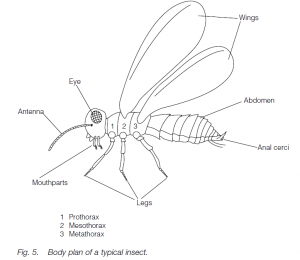
Two super-orders are recognized, the exopterygota and the endopterygota.
- Super-order Exopterygota. These are hemimetabolous. They include the orders Orthoptera (grasshoppers, crickets and locusts), Dictyoptera (cockroaches and mantises), Odonata (dragonflies and damselflies), Ephemeroptera (mayflies), Dermaptera (earwigs), Isoptera (termites) and Hemiptera (aphids and bugs), together with numerous small orders. An example is Locusta migratoria (locust).
- Super-order Endopterygota. These are holometabolous. They include the orders Lepidoptera (butterflies and moths), Trichoptera (caddisflies), Diptera (‘true’ flies), Siphonaptera (fleas), Coleoptera (beetles, the largest insect order with over 400 000 species) and Hymenoptera (bees, wasps and ants), together with several small orders. Examples include Drosophila melanogaster (fruit-fly) and Apis mellifera (honeybee).
-
Sub-phylum Chelicerata (horseshoe crabs, spiders, mites, ticks, scorpions)
There are about 60 000 species of chelicerates. Most are terrestrial, but Limulus and a few other related species are marine. Most chelicerates have six pairs of appendages, of which the first two differ from each other: the chelicerae and the pedipalps respectively. There are four pairs of walking legs, one or more with jaw-like gnathobases. The appendages are primitively biramous but are usually uniramous in land species There are no antennae. The body is divided into a prosoma and an opisthosoma. There are three classes.
(1) Class Merostomata. The horseshoe crab has a dorsal carapace and a long, pointed telson (tail); horseshoe crabs are marine and are of ancient lineage: Palaeozoic Merostomata, the eurypterids, were abundant and attained 3 m in length. An example is Limulus polyphemus (horseshoe crab).
(2) Class Arachnida. There are about 50 000 species of arachnids. Typically they are terrestrial and breathe air through lung-books or tracheae. The four best-known orders are:
(a) Scorpionida (Scorpiones).
In the scorpions, the abdominal opisthosoma is divided into a broader anterior part and a narrow tail bearing a stinging poison gland. The chelicerae are short and powerful, and the pedipalps have large claws. Respiration is by four pairs of lung-books. Scorpions are active predators. An example is Androctonus australis (N. African scorpion).
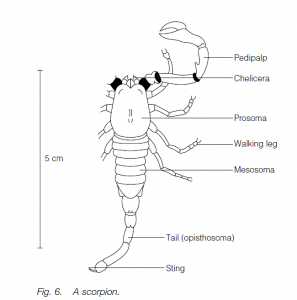
(b) Araneae.
The spiders have a spheroidal opsithosoma attached to the anterior prosoma by a narrow waist. The chelicerae have poison glands, whereas the leg-like pedipalps are sensory. Respiration is by lungbooks and/or tracheae. Spinnerets (adapted appendages) produce gossamer silk from the opisthosoma: the silk is used for webs to catch prey, for cocooning eggs, etc. All spiders are carnivorous, sucking the digested juices from their prey (which they chase or trap). An example is Latrodectus mactans (black widow spider).
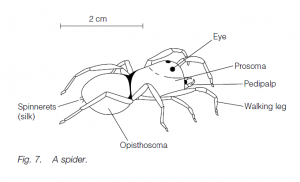
(c) Opiliones (= Phalangida).
The harvestmen lack the waist of spiders and have longer legs. Most are carnivores, but a few eat carrion or are omnivorous. An example is Leiobunum sp.
(d) Acarina.
Ticks and mites have an unconstricted junction between the prosoma and the opsithosoma. The pedipalps may be clawed or leg-like; the chelicerae may be clawed. Tracheae and spiracles are often present. Most acarines are very small, living in a variety of habitats from leaf litters to as parasites on animals. Both herbivores and carnivores are known. An example is Dermacentor variabilis (tick).
(3) Class Pycnogonida. The pycnogonids or sea-spiders are problematically related to the Arachnida. Sea-spiders have a reduced abdomen, no special respiratory or excretory apparatus and four, five or six pairs of walking legs. An example is Nymphon rubrum (sea-spider).
Related phyla Phylum Pentastomida (tongue-worms)
The tongue-worms (about 90 species) are endoparasites in the respiratory tracts of carnivorous vertebrates, especially reptiles. The sexes are separate, and mating occurs in the ‘final’ host. After internal fertilization, the females lay many thousands of shelled eggs which are voided via nasal secretions, saliva or feces. The eggs are eaten by a vertebrate intermediate host and hatch into a larva with four–six jointed, arthropod-like limbs. The intermediate host is eaten by the final host and the larva is freed to migrate to the respiratory tract. Like arthropods, pentastomids have a ventral nerve cord, cerebral ganglia and a hemocoel. An example is Linguatula serrata.
-
Phylum Tardigrada (tardigrades)
The tardigrades or water-bears (about 500 species, <1 mm in length) live in damp intertidal zones, on the edges of freshwater habitats, and on the surface water films of lichens and bryophytes (mosses and liverworts). The sexes are separate. Internal fertilization occurs and the female lays eggs which hatch after 14 days into a juvenile. The juvenile molts to form an adult. Parthenogenesis may be common, especially as some moss-dwelling species seem to have no male individuals. Cryptobiosis – a period of suspended animation when the tardigrades retract their legs, lose water and contract, or very slow metabolism may be seen, which is advantageous when habitats dry out or otherwise become hostile (e.g. extreme cold). Tardigrades have short bodies and four pairs of clawed, short legs. An example is Echiniscus blumi.